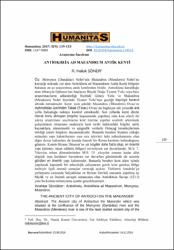| dc.contributor.author | Söner, R. Haluk | |
| dc.date.accessioned | 2018-07-24T07:54:19Z | |
| dc.date.available | 2018-07-24T07:54:19Z | |
| dc.date.issued | 2017 | |
| dc.identifier.uri | https://hdl.handle.net/20.500.11776/2866 | |
| dc.description.abstract | Morsynos (Dandalaz) Nehri’nin Maiandros (Menderes) Nehri’ne karıştığı noktada yer alan Antiokheia ad Maeandrum Antik Kenti bölgede bulunan en az araştırılmış antik kentlerden biridir. Antiokheia kurulduğu alan itibarıyla Ephesos’tan başlayan Büyük Doğu Ticaret Yolu veya bazı araştırmacıların adlandırdığı biçimde Güney Yolu ve Maiandros (Menderes) Nehri üzerinde Ticaret Yolu’nun geçtiği köprüyü kontrol altında tutmaktadır. Kent; aynı şekilde Maiandros (Menderes) Ovası’nı Aphrodisias üzerinden Tabae (Tavas) Ovası’na bağlayan tali yolunda ana yolla buluştuğu noktayı kontrol etmektedir. Son yıllarda kenti direkt olarak konu almayan projeler kapsamında yapılmış olan kısa süreli iki yüzey araştırması sayılmazsa kent üzerine yapılan sistemli arkeolojik çalışmaların olmaması nedeniyle kent tarihi hakkındaki bilgiler antik kaynaklara, nümizmatik ve epigrafik verilerle Ortaçağ kronikçilerinin verdiği sınırlı bilgilere dayanmaktadır. Bununla beraber Stadion olduğu anlaşılan yapı kalıntılarının yanı sıra işlevleri hala anlaşılamamış olan diğer duvar kalıntıları da burada önemli bir Roma kentinin bulunduğunu gösterir. Kentin Bizans Dönemi’ne ait bilgiler daha fazla olup, en önemli yapı kalıntısı iskan edilmiş bölgeyi çevreleyen sur duvarlarıdır. M.S. 7. Yüzyılın erken dönemlerinden M.S. 13. yüzyılın sonuna kadar dört değişik inşa karakteri barındıran sur duvarları günümüzde de arazide görülen en önemli yapı kalıntısıdır. Bununla beraber kent alanı içinde yapılacak kapsamlı bir arkeolojik çalışmanın gerek kent gerekse bölge tarihiyle ilgili önemli sonuçlar vereceği açıktır. Türklerin Anadolu’ya yerleşmesi sırasında Selçuklular ve Bizans Devleti arasında yapılmış üç | en_US |
| dc.description.abstract | The Ancient city of Antiochon the Maeander which was situated at the confluence of the Morsynos (Dandalaz) river and the Maiandros (Menderes) river is one of the least studied ancient city of theregion. Antioch controls the Great Eastern Trade Road as the so-called Southern Road by some scholars and the bridge over the Maeander River which was passing by the Trade Road. The city also controls the junction of the main road and the side road which connects Maeander Valley with TabaeValley passing through Aphrodisias. Because of the lack of systematical archeological studies, the information about the history of the ancient city is based on numismatic, epigraphic evidences and the data provided by medieval chroniclers. Nonetheless, the surface remains like stadion which shows the function of the building and also the other wall remains whose function is couldn’t understood yet demonstrates the existence of an important Roman city in this area. The information about the city from Byzantine Period is much more than the other periods thus the most important structures of the city are defense walls surrounding inhabited area. These walls which are still the most important structures on the land consist four different construction periods from the early 7th century A.D. to the end of 13th century A.D. The last of the three largest and the most important battles, Antioch War (1211) between Seljuks and the Byzantine Empire, during the Turkish settlement in Anatolia was happened in the territory of the city. | en_US |
| dc.language.iso | tur | en_US |
| dc.publisher | Namık Kemal Üniversitesi | en_US |
| dc.rights | info:eu-repo/semantics/openAccess | en_US |
| dc.subject | Antioch | en_US |
| dc.subject | Antioch on the Maeander | en_US |
| dc.subject | Morsynos | en_US |
| dc.subject | Maeander | en_US |
| dc.subject | Antiokheia, Antiokheia ad Maeandrum, Morsynos, Maiandros. | en_US |
| dc.subject | Antiokheia ad Maeandrum | |
| dc.subject | Morsynos | |
| dc.subject | Maiandros | |
| dc.title | Antiokheia Ad Maeandrum Antik Kenti | en_US |
| dc.title.alternative | The Ancıent Cıty Of Antıoch On The Maeander | en_US |
| dc.type | article | en_US |
| dc.relation.ispartof | HUMANITAS - Uluslararası Sosyal Bilimler Dergisi | en_US |
| dc.department | Fakülteler, Fen Edebiyat Fakültesi, Arkeoloji Bölümü | en_US |
| dc.authorid | 115250 | en_US |
| dc.identifier.volume | 5 | en_US |
| dc.identifier.issue | 9 | en_US |
| dc.identifier.startpage | 139 | en_US |
| dc.identifier.endpage | 153 | en_US |
| dc.relation.publicationcategory | Makale - Ulusal Hakemli Dergi - Kurum Öğretim Elemanı | en_US |



















